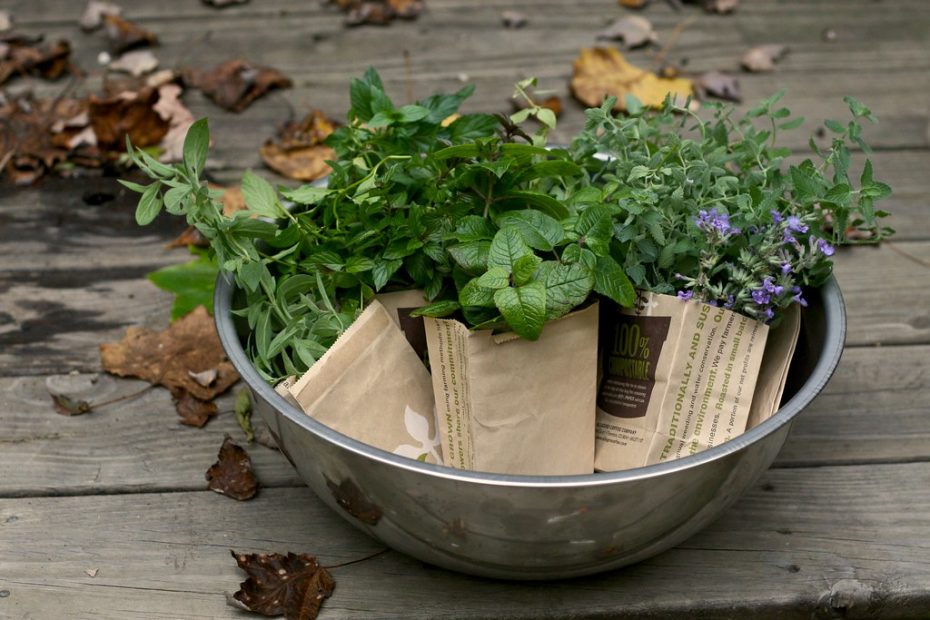Planting your own herbs in the garden and using them in cooking is one of the most satisfying things I’ve done this past year. However, not that winter is coming I was unsure how they would deal with the cold. That’s when I learned about annual, biennial, and perennial herbs. So, are herbs annuals?
Annual herbs are herbs that have a lifecycle of one year. These annual herbs are:
- Basil
- Cilantro
- Chervil
- Marjoram
- Summer Savory
- Coriander
- Dill
In this post, I will go over what annual herbs actually are and how they function. We will also look at which of these herbs are in fact annuals and the relationship between climate and annuality. Lastly, I’ll share some tips on how to keep your annual herbs coming back year after year!
What are annual herbs?
Annual herbs are plants that have a one-year-lifecycle. This means that at the end of the season – usually in winter – the crown and stem of the herb will die off and sow its seeds into the soil for the next season.
Although most annual herbs will attempt to reseed themselves they are rarely successful. In my experience, most reseeding annuals need some extra care to make sure they grow back the next year.
You can think of annual herbs in contrast to biennial or perennial herbs. While annuals typically only last one year, biennials have a lifecycle of two years, and perennials can continue growing over several years. Their crown leaves and stem will simply go dormant in the colder months but reemerge when spring comes around.
The lifecycle of annual herbs
The lifecycle of annual herbs is a fascinating spectacle of nature. Just as we as humans go through seasons of hope, despair, life, and death, each herb follows the exact same pattern every year.
Below you’ll see an overview of the different lifecycles that perennial, biennial and annual herbs go through:
Winter annual herbs start to grow outside in March and will be in full bloom sometime around May. Then, in June they will start sowing their seeds in the nearby soil. The crown leaves and stem dies at around the same time. If conditions are right those seeds will develop into new plants in September, October, and November.
Summer annual herbs are sown in April and start their growth in May. They take a slightly longer time to fully develop and will reach the height of their strength and growth in August. In September these annuals will start to decay and leave their seeds behind for the next year.
Which herbs are annuals?
Annual herbs are basil, cilantro, chervil, marjoram, summer savory, coriander, and dill. These herbs follow a one-year-lifecycle. However, in warmer climates, some of these herbs may actually survive winter and come back strong next year.
Here’s a list of the most common annual herbs:
| Annual Herbs |
| Basil |
| Cilantro |
| Chervil |
| Marjoram |
| Summer Savory |
| Coriander |
| Dill |
Basil is an annual herb native to southern Italy and as such accustomed to warm climates. In winter the cool air and frost force the broad green leaves to fold up and contract for protection. Without the necessary surface to perform photosynthesis the plant then dies and sows its offspring for the next season.
Cilantro actually grows well in milder and cooler climates such as the United Kingdom but cannot survive once the temperature drops too low in winter. Another annual herb that is accustomed to mild climates but does not make it through winter is dill.
Chervil, marjoram, and summer savory are all annual herbs that you will need to regrow the following season. Even though they attempt to reseed when the main plant dies the seeds of these annuals typically do not make it until the warmer months.
Below you’ll find a convenient overview of annual, perennial and biennial herbs:
Annual herbs and zones
Although annual herbs usually just grow for one year – as the name suggests – there are some circumstances that may help an annual herb and its seeds survive winter and grow stronger the following months.
One of these factors is the climate your herb is located in. Below you’ll see a US map of climate zones. Red is the hottest and blue to purple the coldest regions:

If you live and plant your annual herbs in the light orange, orange or red areas (zones 8, 9, 10) there is a good chance that your annual herbs will make it through winter and act like perennials.
However, the warmer climates are not guaranteed to regrow your annuals. Rather it depends on the specific characteristics of the herb plant; the amount of sunlight it got during the previous month and the resilience it has developed through healthy nutrients.
In the next section, we’ll go into a bit more detail on how to regrow your annual herbs year-after-year even if you live in some of the cooler zones!
How to regrow annual herbs
Regrowing annual herbs required some patience and dedication to find the perfect conditions. One of the most effective ways to ensure your annuals make it through winter is to provide them with protection from the cold.
Here are some ways to keep your annual herbs for the next year:
- Protection from cold: Protecting annual herbs from the cold outside can help them thrive longer or even survive winters. This is because their lifecycle is extremely sensitive to temperature changes, so when the leaves are never exposed to lower temperatures the decay and seeding cycle may not be triggered.
- Greenhouse: The ideal way to protect herbs grown outside from cold temperatures and frost is of course a greenhouse. But, you don’t have to build your own just yet. Building a small enclosure with some plastic wrap will ensure that the warm air generated by the sunlight stays inside.
- Indoor growing: Another way to protect annual herbs from the cold is to grow them inside. You could even pot your garden-grown in the fall in preparation for winter. However, some annuals might not deal well with the sudden change in atmosphere and climate.
- Hydroponics: One method that I’m very fond of for keeping annual herbs alive is hydroponics. This simply means that the plants are grown in water instead of soil. Water-grown herbs tend to be more resilient and grow stronger and faster since it is easier for them to extract nutrients. As a result, they have a higher chance of making it through colder months.
- Collect seeds: If you prefer letting your annuals take their natural lifecycle and decay in the fall, a good way to ensure you can regrow them in spring is to collect the seeds from the plant. Taking care of the seeds inside a controlled environment will see a much higher success rate of regrowth than leaving them outside to fend on their own.
Conclusion
Annual herbs can be a challenge to take care of but also rewarding. Personally, I don’t want to miss out on delicious, savory herbs like basil or dill just because they require slightly more care.
Using some of the methods above I’ve found it much easier to keep my annual herbs alive and well during the cold season or have them grow back in spring!
- Are Herbs Perennial? - January 29, 2021
- Can Herbs Survive Winter? - January 28, 2021
- Can Dogs Eat Herbs? - January 27, 2021


